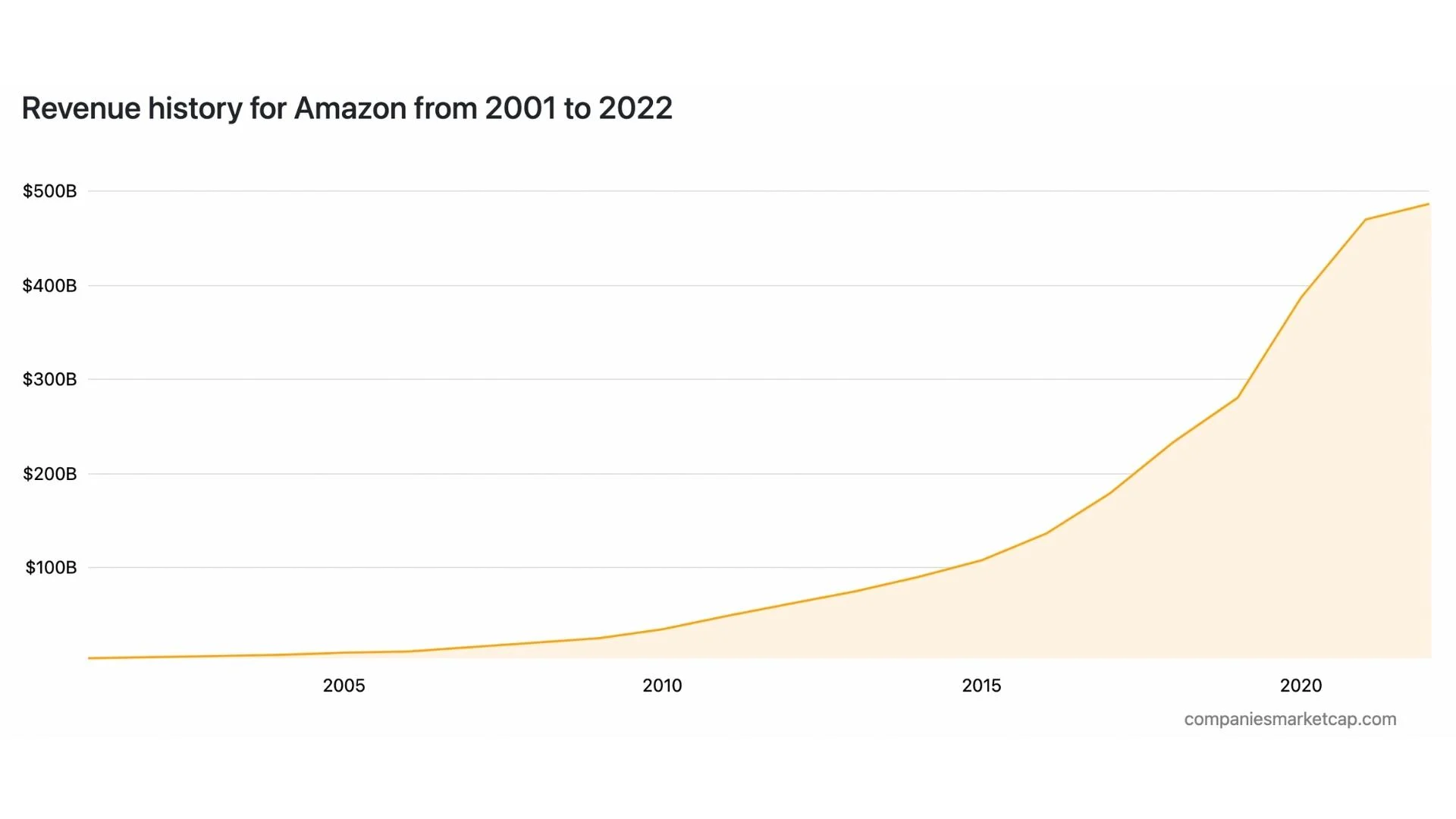- Commerce,
- Personalization
Amazon: The King of E-commerce and Personal Recommendations


When it comes to e-commerce, there is no company more dominant than Amazon. Founded in 1994 by Jeff Bezos, Amazon was one of the first companies to sell goods online and has since become the world’s largest retailer, with over $480 billion in annual sales.

What makes Amazon so successful?
“If we have 4.5 million customers, we shouldn’t have one store. We should have 4.5 million stores.”Jeff Bezos - 1998
A big part of it is their focus on personal recommendations.
Amazon has always been good at making recommendations, even from the early days when they only sold books. They used data from customers’ purchase history and browsing behavior to suggest other titles that might be of interest. This was a revolutionary idea at the time and helped them stand out from other online retailers who were just listing items for sale with no personalized recommendations.
As Amazon has grown, they’ve continued to get better and better at making recommendations, using more data and complex algorithms. They now make recommendations not just for books but for millions of other products across categories like clothing, electronics, and home goods.
And they do it all with the help of machine learning.
Machine learning is a type of artificial intelligence that allows computers to learn from data and get better at tasks over time. Amazon uses machine learning throughout its business, but it’s especially important for its recommendation system.
By using data from customers’ past behavior, Amazon can make predictions about what each customer is likely to want and need. This allows them to show each customer personalized recommendations for products they’re more likely to be interested in.
Amazon’s focus on personal recommendations has been a key part of its success and has helped them become the king of e-commerce.
35% of What Consumers Purchase on Amazon Comes from Product Recommendations
There is no doubt that we are living in a digital age.
More and more businesses are moving away from traditional forms of marketing, such as print ads and direct mail, and towards digital channels.
This shift is being driven by the increasing sophistication of algorithms and predictive models, which are able to analyze data and identify trends more effectively than ever before.
As a result, businesses are able to personalize their advertising messages to a much greater extent. This is having a profound impact on the way that consumers purchase products and services.
Already, a significant proportion of what consumers buy on Amazon and watch on Netflix come from recommendations based on these predictive models.
According to McKinsey, 35 percent of what consumers purchase on Amazon and 75 percent of what they watch on Netflix come from product recommendations based on such algorithms.
It is clear that the influence of mass advertising is waning as businesses increasingly move towards personalized digital marketing.
Amazon’s Secret Formula to Digital Customer Experience: Personalization
Amazon is the e-commerce leader for a reason.
The company understands that personalization is key to providing an excellent customer experience.
From the moment a user arrives on the homepage, they are greeted with personalized recommendations. This personalized approach continues throughout the site, in emails, the mobile app, push notifications, and more.
As a result, Amazon is able to provide a more seamless and tailored experience that keeps users coming back.
Personalization is clearly a key element of Amazon's success, and other companies would be wise to follow their lead.
The Use of Deep Learning and Collaborative Filtering Techniques
Deep learning is a subset of artificial intelligence. Amazon was one of the first companies to adopt deep learning to power its digital customer experience.
By using deep learning and collaborative filtering techniques, Amazon was able to personalize recommendations for its customers better by showing:
Browsing history
Recommended for you items
Best selling in category “XYZ”
Related to items you’ve viewed
Frequently bought together items
Customers who bought this item also bought items
Recommended for you based on your previous purchase
Your recently viewed items and featured recommendations
This led to increased customer satisfaction and loyalty, which helped Amazon become one of the pioneers of e-commerce in the last two decades.
Amazon’s use of deep learning has also helped it improve its search engine results. By understanding the relationships between products, Amazon can provide more relevant search results for its customers.
This has led to increased sales and happier customers.
Amazon Personalization
Product Discovery
Amazon has changed the way we shop.
Not only does it offer a wide variety of products, but it also makes it easy to find what you are looking for. You can either search for a specific product or browse through the various categories. And if you are not sure what you want, Amazon also provides recommendations - taking into account a number of factors, including but not limited to:
location
purchase history
visited items
search query history
liked/bookmarked items
customer reviews
discounts
purchases made by other customers after looking at similar products
This convenience has made Amazon a go-to source for many shoppers.
And while some users may know exactly what they want when they visit the site, others may only have a general idea.
Amazon has become a sort of search engine where the shopping experience begins. No matter what a user’s intent is, Amazon doesn’t pass up the opportunity to capture a sale.
This is just one of the many reasons why Amazon is so successful.
Tailored Discounts and Promotional Offers
Amazon offers a wide variety of discounts and promotional offers to its users.
Promotions take many forms, including:
limited-time deals
event-based discounts
discounts and offers Prime members
discounts and offers for Amazon credit card users
discounts for subscription-based services
discounts and offers on in-house products
Amazon’s vast selection of products and services makes it a go-to source for many shoppers looking for the best deals.
By offering such a wide range of promotional opportunities, Amazon is able to appeal to a broad swath of users and boost its sales significantly.
Additionally, these promotions often result in positive word-of-mouth marketing for the company, as satisfied customers are more likely to tell their friends and family about their great experience.
In short, Amazon's strategic use of promotions is a key driver of its success.
Personalized Logo for Different User Levels
As any e-commerce retailer knows, customer loyalty is essential for long-term success.
One way to foster loyalty is to offer VIP treatment to members of an exclusive club or group. This is exactly what Amazon does with its Prime membership program. Prime members enjoy free shipping, early access to deals, and exclusive discounts.
To remind its Prime members of their status, Amazon shows them a special logo when they log in to their account.
This not only makes members feel appreciated, but Amazon also intelligently reminds its customers of their membership status.
Amazon tries to make sure that the membership status and benefits are at the top of the user's mind. It wants its users to know about all the special benefits that come with paying for a membership so that people who don't pay will feel like they're missing out.
As a result, this simple branding strategy helps to strengthen customer loyalty and keep Prime members coming back.
Cross-Device/Channel Personalization
Amazon has long been a trailblazer in the world of personalization, thanks in large part to its ability to link together all of its digital properties.
By maintaining a 360-degree view of the customer, Amazon is able to identify the same individuals across devices and quickly capture user data at every touchpoint. This allows it to effectively track and match user profiles for the delivery of personalized shopping experiences along the customer journey.
Amazon knows that in order to provide a truly personalized experience, it needs to understand who is browsing and interacting with its brand. That's why it encourages users to log into their accounts, regardless of membership level. By doing so, Amazon is able to access browsing history, lists, saved items, and other data that can be used to create a more tailored shopping experience across channels and devices.
In recent years, other companies have begun to adopt similar approaches, but Amazon remains ahead of the curve thanks to its vast trove of data and its continued commitment to innovation.
The Bottom Line: Start Personalizing Your Website to Increase Conversions and Boost Sales
In a world where online shoppers have nearly endless choices, it's more important than ever for companies to differentiate themselves.
One way to do this is through personalization.
By tailoring the shopper's experience to their individual preferences, you can create a sense of connection and build loyalty.
Amazon is a prime example of a company that has mastered the art of personalization. Through features like recommendation engines and 1-Click ordering, they have created a seamless shopping experience that keeps customers coming back.
If you want to stay competitive in the online marketplace, it's time to start personalizing your website. By doing so, you'll be able to increase conversions and boost sales.
Learn how to deliver unique and personalized customer experiences to increase conversions


